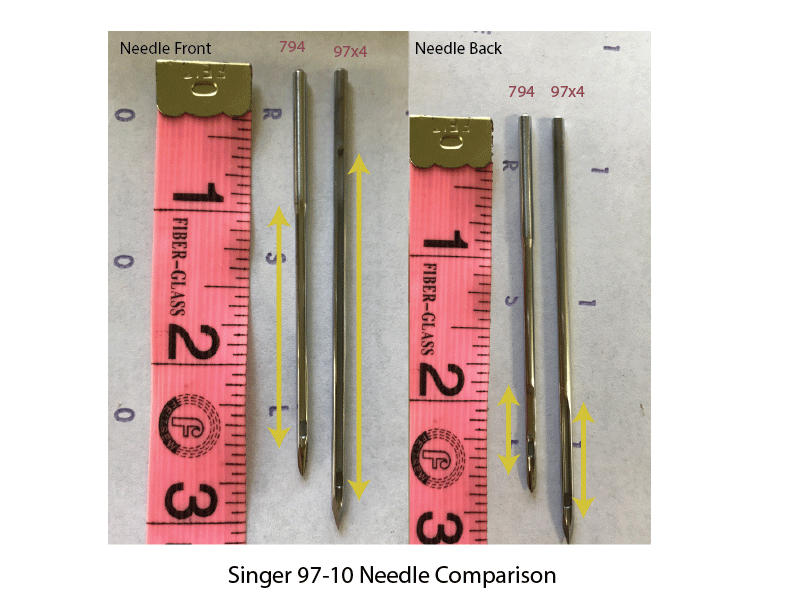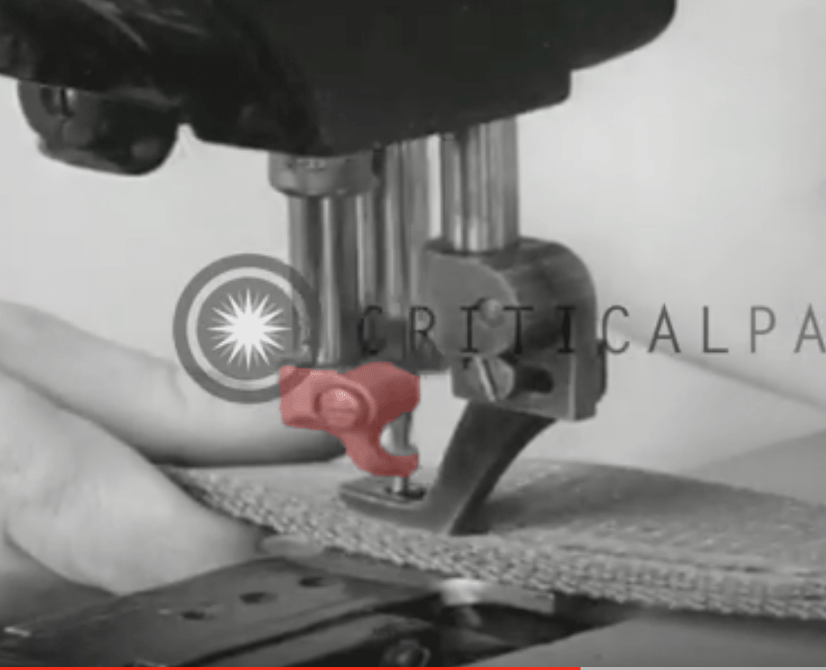-
Posts
23 -
Joined
-
Last visited
wendlynne's Achievements

Member (2/4)
-

Wendy has Singer 97-10 questions AGAIN =)
wendlynne replied to wendlynne's topic in Leather Sewing Machines
Oh wow, if you think that would work I don't mind a twisted leather point at all. I think it looks pretty! So you think those both would work, shank-size wise? I'll give you a ring tomorrow Bob, thank you so so much! -

Wendy has Singer 97-10 questions AGAIN =)
wendlynne replied to wendlynne's topic in Leather Sewing Machines
Thank you so much Bob!! =D -
Singer 97-10 Fun! You guys are so patient and helpful, so thank you. I'm having some trouble with the needles I've been using with the 97-10, I've got the schmetz 794 series that are 1/4" shorter than the original needles and I ground off 1/4" of the shank so I slip that up in the needle guide holder and it works pretty well. However, the groove/channel for the thread is MUCH shorter (on both sides), and that causes occasional problems when you're in thicker leather. I have a friend who ground out a little channel in his needle guide for the thread to lay in for that issue, but it's still not QUITE right. Also, occasionally when you're in cheap, tough vegtan it will pop out of the holder because it doesn't grip it as well. So then your needle gets stuck in the leather and pops out of the holder, so not quite ideal. I know the singer 1000 series needles are also supposed to work - are they the same as the 794? I can't seem to find specs on them that give the depth of the thread channel to see if it will work a bit smoother than the 794s, but some old threads here say they're 1/8" shorter rather than 1/4" so I'm hoping the channel is a bit longer. Can anyone confirm who has some on hand? Attached is a comparison photo for scale. Yes I do have some OEM needles but not a lot, and I like to use a slightly smaller needle than what I have on hand in OEMs. And yes, I know the needles are no longer made, etc., but I got a great deal on this machine and love the old beast. I'd rather find a way to make her work than retire her. THANK YOU!
-

Prettiest singer 111w155... biggest pain in my butt
wendlynne replied to BrownChicken's topic in Leather Sewing Machines
yeah, but the decal quality swings pretty widely between sellers on ebay. Some are just horrible scans on cheap materials =O- 24 replies
-
- tension release guide
- singer 111
-
(and 1 more)
Tagged with:
-

Prettiest singer 111w155... biggest pain in my butt
wendlynne replied to BrownChicken's topic in Leather Sewing Machines
The decals, the pretty. I am so impressed. And I would love to know where you got the decals as well!- 24 replies
-
- tension release guide
- singer 111
-
(and 1 more)
Tagged with:
-
Yeti, thank you for these guides as well, INFINITELY better than the scrappy pdfs I've been trying to work off. I feel a bit recharged!
-
YOU are such a gem, thank you thank you!! I don't have any reliable OCR software so I was going MAD looking for the parts numbers in tiny print. I do have the plates, and know a good machinist, but without an original to copy I probably won't get too far, will i? I suppose I just cross my fingers and hope something turns up in your stash, I would be so grateful. They really are lovely machines. You ALL are so helpful, thanks for tolerating my questions. I really do try to do my homework before I pester anyone here, but it can get a little overwhelming sometimes. So helpful to check my sanity here. Well, at least THIS part of my sanity
-
Oh! And do you think there might be a part similar or equivalent on a 7 class or other big machine? Even if it's not a perfect fit, just having one I could try to machine or scan and make adjustments to would be easier than thin air, you know?
-
Bob! You're genius, thank you. I feel a bit silly for not recognizing the screw on the right side, so accustomed to pressure foot adjustments on the left for garment machines You know, the joys of living in the era we do, I have hope these girls will hit their renaissance. They are 3D printing some pretty amazing aviation parts now, and classic car parts for pennies on the dollar of what they used to cost. Of course we're not able to do tempered steel, but I feel like we're at a pivotal point. I suppose if I find one I can borrow to scan, I might be able to pester the 3D printer in town and see where their metal composites are. Probably would be easier to get my dad's buddy to machine one for me, I just need reliable specs/schematics? I presume? I found another 97 not too far away, but they're running it without the needle guide. Just an empty stump! Poor girl.
-
Hello all, So Bertha the 97-10 lives in my studio. She's a good girl, but I think there's some issues that need some work so I'm looking for other 97-10 owners or folks who have sewn on one to chime in here on a few questions. 1) Tension when presser foot is raised - I'm accustomed to the second tension closer to the needle releasing when the presser foot is raised. Can anyone confirm that this is true on the 97-10? I've always been told by my industrial sewing mechanics it's quite bad for machines to yank the thread without releasing tension, so it seems odd that doesn't happen here. 2) Presser Foot Tension - ok, so the presser foot seems to not have adjustable tension? Is this right? Or am I missing it? 4) Parts parts. I am looking for a part, wondering if anyone knows if there is an equivalent that miiiight work for a 97-10. Bar thingy - ok I've looked through the parts list, I can't seem to find the part and name for the piece that is below the needle bar, that stabilizes the needle. Comes down on the original part on a curve, about a 45 degree angle to the leather. On my machine that's an aftermarket part and isn't angled, so I'd like to get a curved equivalent piece as the block marks up the leather a bit sometimes. Or, just know what it's called. I took a screen grab from the only video of a 97-10 stitching I could find, and highlighted in red the part I need in the picture attached =) Thanks all! Wendy
-
My pleasure! That's the fun of the equine industry, right? So so many opinions, nearly all of them subjective and qualitative. Based upon our experiences with the animals and observation, but very difficult to test and put numbers to. Personally, I think that most clinicians and vets I trust say that there should be as little pressure as possible in the whither area, weight is only ideally distributed along the bars. Specifically this is an issue with length in western saddles, I've had a lot of issues with two geldings in particular who have had pelvic issues exactly like schleiss describes from the bar length. For me, if I have pressure in the whither area or shoulder at all? You're doing it wrong. Therefore a cutout only serves to alleviate pressure potential from shifts and the horses movement, and is nowhere near the bar area where pressure should be distributed. But again, without a sensor under the saddle pad (those ARE pretty cool, but 300 a day to rent) it's just qualitative data. Three horse people in a room, not a single opinion will align perfectly. All the best, you're headed into a hotly contested area in equine development. I do highly encourage you to learn a bit about fibers and length/quality and do your own examination under a microscope, as your vet will have no experience visually identifying them. Burn testing as well. Sadly, even the best of textile converters have to work with their own suppliers, I would be asking a LOT of questions about their lab, QA process, whether they use independent external labs to test their suppliers or whether they test at ALL. I have walked the floor of a few labs, and I can assure you that most companies rely on trust and aren't testing their fibers. Most apparel companies have been forced to set up their own internal labs to QA, as the converters simply don't and the fibers change from lot to lot, and consequently the quality. If Patagonia and Nike can't trust their suppliers and/or find any that test to their satisfaction, well in my opinion neither should you. Good luck out there!
- 12 replies
-
- saddle pad
- material
-
(and 3 more)
Tagged with:
-
So, new to leatherwork, much more well-versed in textile restoration and sciences than leather so I need a little advice. My mother and I have a little custom business where we create headstalls to coordinate with show blankets and tack. I'm still learning on leather so we're working with a very sweet supplier, but his english is a little scant for help in this department. My mom, not knowing, put all the light leather tack in the same bag as the chocolate leather tack. Consequently three lovely sets of light split reins and one headstall have leeched oil and color from the dark leather. I caught it as quick as I could and did a quick glycerin soap, but it's hardly put a dent in the spots and I'm guessing we'll now have to transition these to dark leather as well. Before we move to dye them, so as to keep mom from crying any more about "ruining everything" despite my best efforts to let her know it was an easy mistake, any ideas as to possibly evening out the tone a bit? My mom wants to put them out in the sun and I had to take the windex away from her. =p Any thoughts are appreciated, or just confirmation we should not waste our time with too much effort and just dye them dark.
-
Oh, and P.S. Invest in a USB microscope (about 70-90 dollars on amazon) and learn how to do a burn test on your wool. There are testing facilities in textile labs for a reason, manufacturers lie about fiber content more than you'd like to imagine. What you're THINKING is 90% wool might be closer to 70%. What are supposed to be carded fibers may be infinitely shorter. The only way to know is to get in there, pull the fibers apart, and evaluate it yourself. That's the only way you'll get a sense of what is really going on with that fabric. A loop with 15x magnification just won't cut it.
- 12 replies
-
- saddle pad
- material
-
(and 3 more)
Tagged with:








